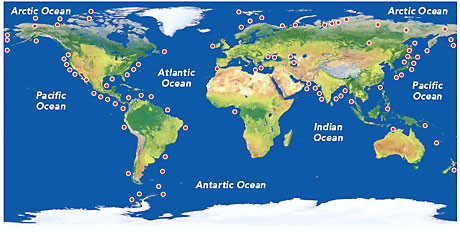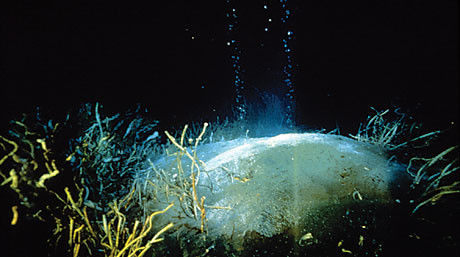SHARE:
Energy
Energy on Ice
The side effects of the Gulf oil spill could include pushing a potential new source of energy into the spotlight
 Methane hydrates are found all over the world, both undersea in coastal regions and onshore in permafrost. If only 1% of the methane in the North Slope area of Alaska can be recovered, "the nation would more than double its natural gas resources," according to the USGS. |
For both energy and climate-related reasons, the federal government has been studying hydrates for some time. Since 2008, the Department of Energy's Methane Hydrates Program has funded at least 34 methane hydrate projects. That year, for example, the Department of Energy spent $2 million on five projects, including assessments of how to measure how much methane hydrate there is, how best to find it and whether it can be safely and economically extracted for use as fuel. With DOE assistance, ConocoPhillips and BP Exploration Alaska are creating test wells in Alaska this year and in 2011 to explore how to extract methane from methane hydrates. A regional government in Alaska also is working on a methane hydrate project.
In 2007 and again in late 2009, MacDonald was among the scientists on a research ship in the Gulf that took measurements in an area called Mississippi Canyon 118, within just a few miles of the Deepwater Horizon well. The scientists, who of course had no idea the well would explode a few months later, ended up with a trove of data that's being used to compare the Gulf's water quality pre- and post-spill.
What they were looking for at the time, however, was the flow of methane into — and from — areas where hydrates are known to form. The research venture was part of a program called Hyflux that is funded by the DOE, which expects commercial production of methane from methane hydrates by 2015 from arctic deposits and by 2025 from deposits on the seafloor in the Gulf and elsewhere. Meanwhile, countries such as Korea, Japan and India that have few or no oil resources "are looking very closely at their gas hydrates," MacDonald says, and have cooperated with U.S. scientists and the U.S. government on research. "China has a very well funded center" investigating hydrate production.
According to the Department of Energy, the most promising technology for producing methane from hydrates is simply finding a way to depressurize the hydrate and then capturing the released methane. A major challenge in extracting methane is for the extraction method not to destabilize the larger deposit. MacDonald says the pinnacle of hydrate research involves a method of pushing carbon dioxide into a hydrate in such a way that it would shove the methane out while preserving the hydrate. The approach, he says, would be both elegant and ecologically beneficial: The hydrate's solid structure itself would remain intact, even as methane was removed for use as an energy source; meanwhile, the swap would create a "sink" where CO2, a greenhouse gas, could be stored. "That's the Holy Grail," he says.
For MacDonald, the wisdom of exploiting hydrates is clear: "We do need to be concerned about methane as a driver of greenhouse gas,'' he says. "But if we can produce gas from the deep ocean and replace coal, then that's a real win for the planet. Burning methane is better than burning coal or oil. If we could stop burning coal altogether, it could buy us some time to reduce CO2 emissions."
The ultimate challenge hydrates pose is to our political will to make good, rational decisions, MacDonald says. Weighing all the considerations, he sees the offshore production of gas — plentiful in waters near Florida — as preferable to drilling for oil, for example, and much preferable to blowing the tops off mountains in West Virginia and Kentucky to mine coal.
But he cautions that the Deepwater Horizon spill has created an awareness that the world — particularly the exotic realms of the deep ocean — is "more complicated than we imagined" in terms of our ability to set processes and events in motion "that we can't lasso or contain." Framing decisions constantly as a battle between our ecology and the economy is counterproductive, he says. "We need to make difficult choices with an eye to the future and an eye to the real costs that they incur. As we now see, the real costs of oil production in the ocean are far greater than we've been paying, particularly if we're paying for the cure rather than prevention, as with BP."
"In that context," MacDonald says, "gas production in the ocean, if done with rigorous regulatory oversight, remains a viable option."
 Methane hydrates represent "the Earth's biggest potential source of hydrocarbon energy," according to the U.S. Department of Energy — more carbon, possibly, than is contained in all the other known coal, gas and oil on the planet. [Photo courtesy Ian MacDonald] |























